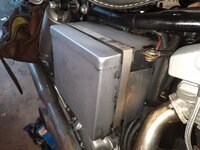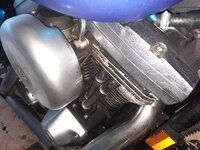Just before Christmas in the UK, we had a week or so with temperatures around zero. Everything in the garage got cold, and stayed cold. The 'garage' is an old barn, 45 feet long, ten feet wide and nine feet high with a corrugated tin roof only partly insulated. The wall mostly plywood and breezeblock. With ample 'ventilation' through certain critters getting in (nesting birds in the main) and rubbish contruction, heating such an area would need a King's ransom.
Then the temps went up by around ten degrees and we had fog, high humidity. Nature allows humidity, in the form of moisture, to condense on anything cold, so everything - metal, cardboard, plastics, paper, becomes covered in 'dew'. Beneath its cover, the FL was wet. Everything was wet. Cardboard went soggy, boxes became unmoveable without the contents dropping through, etc. That's Nature for you.
I could have covered the bike in a big plastic bag and put a blow heater on low, but once the cold surfaces reached the ambient air temperature, Nature once again caused the 'wet' to evaporate back into the air.
As Ron and others have suggested, plugs out, in gear, turn the engine over with the back wheel. Get some oil circulating and seals kept moist, and stop clutch plates sticking. Starting needs to be followed by a ten mile run to remove internal condensation. Five minutes on tickover will cause more problems than it will be perceived to solve. I've heard it said that 60% of an engines wear takes place in the first 90 seconds from cold. Tyres pumped up hard, or (preferably) off the ground if longer than a month. Mines on the deck, but gets moved around. Some say fuel tank empty. I prefer full, but drain the carb bowl. Bloody E10 crap.
Had a neighbour once who used to jump in his car, start the engine in gear with foot on the clutch, then launch off at high rpm. He got through engines like most get through Weetabix. He wasn't one for listening to advice.



